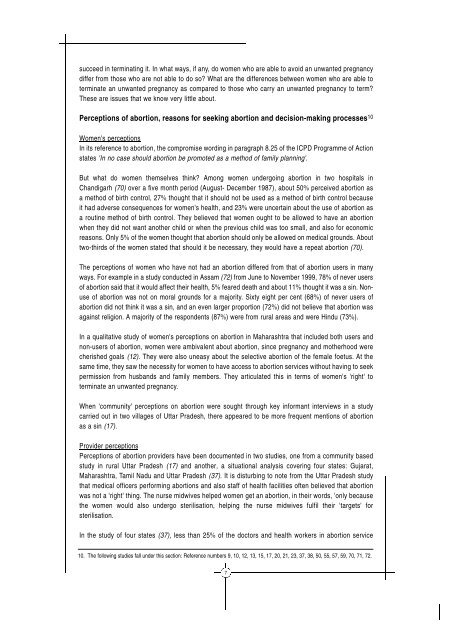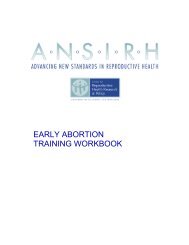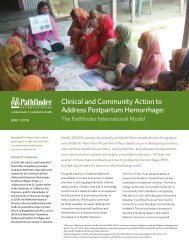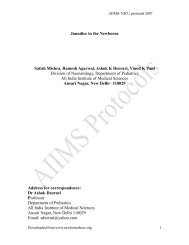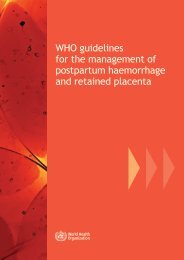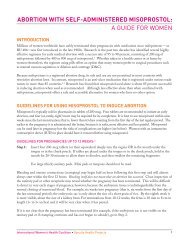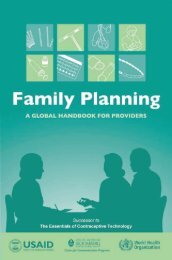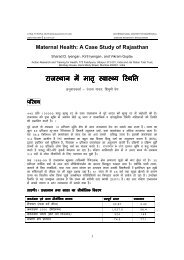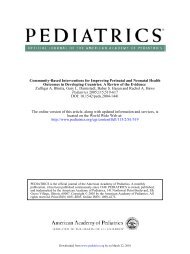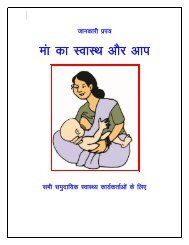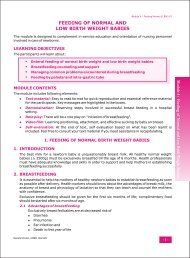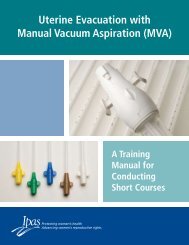Gender Gaps in Research on Abortion in India - CommonHealth
Gender Gaps in Research on Abortion in India - CommonHealth
Gender Gaps in Research on Abortion in India - CommonHealth
Create successful ePaper yourself
Turn your PDF publications into a flip-book with our unique Google optimized e-Paper software.
succeed <str<strong>on</strong>g>in</str<strong>on</strong>g> term<str<strong>on</strong>g>in</str<strong>on</strong>g>at<str<strong>on</strong>g>in</str<strong>on</strong>g>g it. In what ways, if any, do women who are able to avoid an unwanted pregnancy<br />
differ from those who are not able to do so? What are the differences between women who are able to<br />
term<str<strong>on</strong>g>in</str<strong>on</strong>g>ate an unwanted pregnancy as compared to those who carry an unwanted pregnancy to term?<br />
These are issues that we know very little about.<br />
Percepti<strong>on</strong>s of aborti<strong>on</strong>, reas<strong>on</strong>s for seek<str<strong>on</strong>g>in</str<strong>on</strong>g>g aborti<strong>on</strong> and decisi<strong>on</strong>-mak<str<strong>on</strong>g>in</str<strong>on</strong>g>g processes 10<br />
Women's percepti<strong>on</strong>s<br />
In its reference to aborti<strong>on</strong>, the compromise word<str<strong>on</strong>g>in</str<strong>on</strong>g>g <str<strong>on</strong>g>in</str<strong>on</strong>g> paragraph 8.25 of the ICPD Programme of Acti<strong>on</strong><br />
states 'In no case should aborti<strong>on</strong> be promoted as a method of family plann<str<strong>on</strong>g>in</str<strong>on</strong>g>g'.<br />
But what do women themselves th<str<strong>on</strong>g>in</str<strong>on</strong>g>k? Am<strong>on</strong>g women undergo<str<strong>on</strong>g>in</str<strong>on</strong>g>g aborti<strong>on</strong> <str<strong>on</strong>g>in</str<strong>on</strong>g> two hospitals <str<strong>on</strong>g>in</str<strong>on</strong>g><br />
Chandigarh (70) over a five m<strong>on</strong>th period (August- December 1987), about 50% perceived aborti<strong>on</strong> as<br />
a method of birth c<strong>on</strong>trol, 27% thought that it should not be used as a method of birth c<strong>on</strong>trol because<br />
it had adverse c<strong>on</strong>sequences for women's health, and 23% were uncerta<str<strong>on</strong>g>in</str<strong>on</strong>g> about the use of aborti<strong>on</strong> as<br />
a rout<str<strong>on</strong>g>in</str<strong>on</strong>g>e method of birth c<strong>on</strong>trol. They believed that women ought to be allowed to have an aborti<strong>on</strong><br />
when they did not want another child or when the previous child was too small, and also for ec<strong>on</strong>omic<br />
reas<strong>on</strong>s. Only 5% of the women thought that aborti<strong>on</strong> should <strong>on</strong>ly be allowed <strong>on</strong> medical grounds. About<br />
two-thirds of the women stated that should it be necessary, they would have a repeat aborti<strong>on</strong> (70).<br />
The percepti<strong>on</strong>s of women who have not had an aborti<strong>on</strong> differed from that of aborti<strong>on</strong> users <str<strong>on</strong>g>in</str<strong>on</strong>g> many<br />
ways. For example <str<strong>on</strong>g>in</str<strong>on</strong>g> a study c<strong>on</strong>ducted <str<strong>on</strong>g>in</str<strong>on</strong>g> Assam (72) from June to November 1999, 78% of never users<br />
of aborti<strong>on</strong> said that it would affect their health, 5% feared death and about 11% thought it was a s<str<strong>on</strong>g>in</str<strong>on</strong>g>. N<strong>on</strong>use<br />
of aborti<strong>on</strong> was not <strong>on</strong> moral grounds for a majority. Sixty eight per cent (68%) of never users of<br />
aborti<strong>on</strong> did not th<str<strong>on</strong>g>in</str<strong>on</strong>g>k it was a s<str<strong>on</strong>g>in</str<strong>on</strong>g>, and an even larger proporti<strong>on</strong> (72%) did not believe that aborti<strong>on</strong> was<br />
aga<str<strong>on</strong>g>in</str<strong>on</strong>g>st religi<strong>on</strong>. A majority of the resp<strong>on</strong>dents (87%) were from rural areas and were H<str<strong>on</strong>g>in</str<strong>on</strong>g>du (73%).<br />
In a qualitative study of women's percepti<strong>on</strong>s <strong>on</strong> aborti<strong>on</strong> <str<strong>on</strong>g>in</str<strong>on</strong>g> Maharashtra that <str<strong>on</strong>g>in</str<strong>on</strong>g>cluded both users and<br />
n<strong>on</strong>-users of aborti<strong>on</strong>, women were ambivalent about aborti<strong>on</strong>, s<str<strong>on</strong>g>in</str<strong>on</strong>g>ce pregnancy and motherhood were<br />
cherished goals (12). They were also uneasy about the selective aborti<strong>on</strong> of the female foetus. At the<br />
same time, they saw the necessity for women to have access to aborti<strong>on</strong> services without hav<str<strong>on</strong>g>in</str<strong>on</strong>g>g to seek<br />
permissi<strong>on</strong> from husbands and family members. They articulated this <str<strong>on</strong>g>in</str<strong>on</strong>g> terms of women's 'right' to<br />
term<str<strong>on</strong>g>in</str<strong>on</strong>g>ate an unwanted pregnancy.<br />
When 'community' percepti<strong>on</strong>s <strong>on</strong> aborti<strong>on</strong> were sought through key <str<strong>on</strong>g>in</str<strong>on</strong>g>formant <str<strong>on</strong>g>in</str<strong>on</strong>g>terviews <str<strong>on</strong>g>in</str<strong>on</strong>g> a study<br />
carried out <str<strong>on</strong>g>in</str<strong>on</strong>g> two villages of Uttar Pradesh, there appeared to be more frequent menti<strong>on</strong>s of aborti<strong>on</strong><br />
as a s<str<strong>on</strong>g>in</str<strong>on</strong>g> (17).<br />
Provider percepti<strong>on</strong>s<br />
Percepti<strong>on</strong>s of aborti<strong>on</strong> providers have been documented <str<strong>on</strong>g>in</str<strong>on</strong>g> two studies, <strong>on</strong>e from a community based<br />
study <str<strong>on</strong>g>in</str<strong>on</strong>g> rural Uttar Pradesh (17) and another, a situati<strong>on</strong>al analysis cover<str<strong>on</strong>g>in</str<strong>on</strong>g>g four states: Gujarat,<br />
Maharashtra, Tamil Nadu and Uttar Pradesh (37). It is disturb<str<strong>on</strong>g>in</str<strong>on</strong>g>g to note from the Uttar Pradesh study<br />
that medical officers perform<str<strong>on</strong>g>in</str<strong>on</strong>g>g aborti<strong>on</strong>s and also staff of health facilities often believed that aborti<strong>on</strong><br />
was not a 'right' th<str<strong>on</strong>g>in</str<strong>on</strong>g>g. The nurse midwives helped women get an aborti<strong>on</strong>, <str<strong>on</strong>g>in</str<strong>on</strong>g> their words, '<strong>on</strong>ly because<br />
the women would also undergo sterilisati<strong>on</strong>, help<str<strong>on</strong>g>in</str<strong>on</strong>g>g the nurse midwives fulfil their 'targets' for<br />
sterilisati<strong>on</strong>.<br />
In the study of four states (37), less than 25% of the doctors and health workers <str<strong>on</strong>g>in</str<strong>on</strong>g> aborti<strong>on</strong> service<br />
10. The follow<str<strong>on</strong>g>in</str<strong>on</strong>g>g studies fall under this secti<strong>on</strong>: Reference numbers 9, 10, 12, 13, 15, 17, 20, 21, 23, 37, 38, 50, 55, 57, 59, 70, 71, 72.<br />
7


